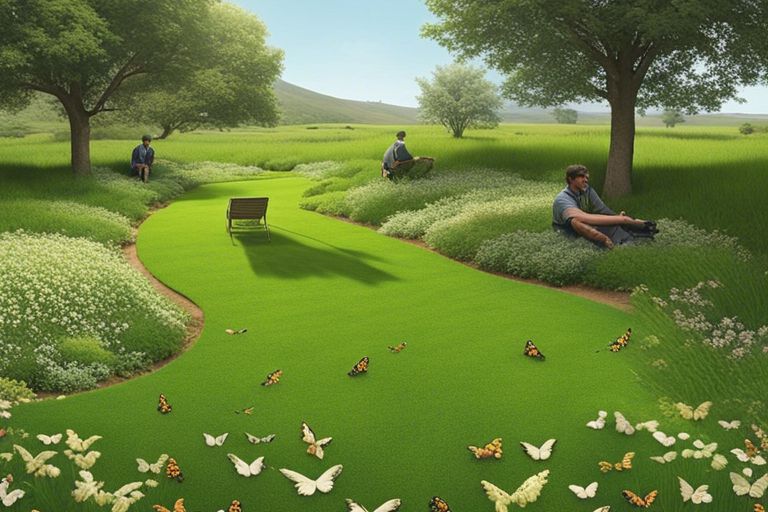Just as a well-tended garden nurtures the soil, choosing grass in a landscaper’s roll offers profound ecological benefits that go beyond mere aesthetics. You may not realize that this choice can significantly contribute to soil health, water conservation, and biodiversity. By embracing grass, you can create a vibrant habitat that supports local wildlife and cultivates a resilient ecosystem. In this post, we’ll explore how your landscape choices can harmonize with nature, enhancing not only your property’s allure but also the environment around you.
Key Takeaways:
- Improved Biodiversity: Choosing grass in a landscaper’s roll promotes a diverse ecosystem, providing habitat for various species and supporting local wildlife.
- Soil Health: Grass contributes to soil integrity by preventing erosion, improving water retention, and enhancing nutrient cycling through its root system.
- Air Quality Enhancement: Grass acts as a natural air filter, absorbing carbon dioxide and releasing oxygen, which contributes to better air quality in the environment.
Environmental Advantages
The choice of grass in a landscaper’s roll brings about a multitude of ecological benefits that can significantly enhance the environment around you. From promoting biodiversity to improving water quality and climate resilience, these advantages extend far beyond mere aesthetics. In your pursuit of sustainable landscaping, understanding how these environmental benefits unfold will empower you to make wise decisions for your outdoor spaces.
Soil Erosion Prevention
Any gardener will tell you that healthy soil is the foundation of a thriving ecosystem. By establishing a robust grass layer, you can effectively combat soil erosion. Grass roots intertwine and create a dense mat that holds the soil together, reducing the impact of rain and preventing the wash away of valuable topsoil. This is particularly crucial in sloped areas, where the risk of erosion is heightened. By choosing grass, you contribute to a more stable soil structure, ultimately enhancing the health of your landscape.
This natural barrier not only preserves the soil’s integrity but also protects the waterways in your vicinity. With less erosion, you reduce sediment runoff that can cloud rivers and streams, harming aquatic life. Hence, your choice of grass acts as a vital line of defense, ensuring that nature’s delicate balance stays intact.
Water Conservation
Soil health and water conservation go hand in hand. When you opt for grass, you tap into a powerful tool for conserving water in your landscape. Grass has a remarkable ability to absorb rainfall and store moisture, which reduces the need for supplemental irrigation. This is particularly crucial in regions plagued by drought or water scarcity, where every drop counts.
Conservation becomes more apparent when you realize that healthy grass can also improve the water infiltration rate of your soil. This means that during heavy rains, more water is absorbed instead of running off, lessening the burden on stormwater systems and minimizing flooding. In addition to this, maintaining grass promotes the natural filtration of pollutants, which leads to improved water quality in the groundwater and nearby bodies of water. By making the conscious decision to use grass in your landscaping, you’re not just beautifying your environment; you’re becoming a steward of the water resources that sustain us all.
Biodiversity Enhancement
Some of the most profound benefits of choosing grass in a landscaper’s roll revolve around its ability to enhance biodiversity. By selecting native grasses for your landscape, you create a thriving environment that serves as a sanctuary for various species. This not only supports wildlife, but it also fosters a balanced ecosystem, paving a pathway to a more sustainable future. Every blade of grass you incorporate offers a tiny yet significant disruption to the monotony of urban landscapes, weaving a verdant tapestry that invites nature to flourish.
Habitat Creation for Wildlife
An enriched grass landscape can provide crucial habitats for a diverse array of wildlife. Birds, insects, and small mammals all find refuge in the thick cover of grass, which serves as a nesting ground and a source of food. Your choice to cultivate these areas can transform an ordinary yard into a vibrant ecosystem, wherein beneficial insects like pollinators thrive. As various species take up residence, they contribute to a fascinating interplay of life that echoes the rhythms of nature.
By planting native grasses, you also create a structure that helps to mitigate the impact of environmental changes. This habitat not only supports existing wildlife but can also attract new species, enriching your garden’s biodiversity. Ultimately, fostering these habitats with your careful considerations will echo into the larger landscape, creating patches of life that benefit your local ecosystem.
Plant Species Diversity
With the incorporation of various grass types, you pave the way for increased plant species diversity. Diverse plant life forms a complex web that underpins the health of your yard. By introducing a range of native grasses, you promote soil health, create microclimates, and provide resources for a myriad of insects and animals. This diversity not only benefits your garden but also provides resilience against pests and diseases, reducing the need for harmful chemicals.
Plus, a thriving diversity of grasses encourages a continual exchange of nutrients in the soil, which nurtures stronger root systems and enhances the overall vigor of your landscape. This diversity is often the key to thriving ecosystems, where every species plays a role—supporting pollinators, attracting birds, and forming an intricate web of life. By thoughtfully selecting a mix of native grasses, you create a vibrant, interconnected habitat that is much greater than the sum of its parts, allowing your landscape to both flourish and sustain itself over time.

Climate Regulation
Keep in mind that embracing grass in your landscaping not only enhances the beauty of your terrain but also plays a pivotal role in climate regulation. A vibrant lawn contributes to the environment by interacting with the atmosphere in significant ways, particularly through the processes of carbon sequestration and microclimate moderation, both of which are vital for sustaining ecological balance.
Carbon Sequestration
An important benefit of grass is its ability to absorb carbon dioxide, a major contributor to climate change. Through the natural process of photosynthesis, grass captures carbon from the atmosphere and stores it in its roots and surrounding soil. This carbon sequestration not only helps to mitigate the effects of greenhouse gases but also enriches the soil, leading to healthier ecosystems. By choosing grass in your landscaping, you are actively participating in the fight against climate change, thus nurturing a healthier planet.
Moreover, the deeper the roots of grass grow, the more effective they are at capturing carbon. This is why opting for species that thrive in your local conditions can significantly enhance your lawn’s carbon storage capabilities. By investing in a landscape that includes grass, you are contributing to a more stable climate and fostering a symbiotic relationship with the earth.
Microclimate Moderation
Regulation of microclimates is another crucial ecological benefit provided by grass. A well-maintained lawn helps to cool the surrounding air through the process of evapotranspiration, where grass plants release moisture into the atmosphere. This cooling effect is vital in urban spaces, where heat islands can form due to concrete and asphalt dominance. By choosing grass, you create a greener oasis that combats rising temperatures, providing a comfortable environment for both you and local wildlife.
Carbon levels are important to monitor as they directly affect air quality and overall environmental health. Grasslands act as natural air filters, removing pollutants and contributing to cleaner air. By incorporating grass into your landscape, you not only improve your immediate surroundings but also support the broader ecosystem by encouraging biodiversity and creating habitats for various species. This simple choice helps foster a thriving, balanced environment where both nature and humanity can coexist harmoniously.
Air Quality Improvement
Now, when contemplating the ecological benefits of choosing grass in a landscaper’s roll, air quality improvement emerges as a significant and often overlooked aspect. Your lawn does more than provide an aesthetic pleasure; it plays a vital role in enhancing the air quality in your environment. As you might discover through The Environmental Benefits of Your Lawn, incorporating grass into your landscape helps create a healthier atmosphere for you and your community.
Oxygen Production
To understand the impact of grass on air quality, one must appreciate its remarkable ability to produce oxygen. Grass, through the process of photosynthesis, absorbs carbon dioxide from the air and releases the oxygen that you breathe. It is estimated that one acre of grass can produce enough oxygen to support two families of four for an entire year. This natural process not only sustains your life but also the life of countless other organisms in your ecosystem.
To cultivate a healthy lawn, you inadvertently contribute to the creation of a more breathable community. The lush green blades catch sunlight and, in their own quiet way, transform it into vital life-sustaining air. Maintaining your grass not only beautifies your surroundings but also amplifies your role as a guardian of the air we share.
Particulate Matter Reduction
The benefits of grass extend beyond oxygen production to the reduction of particulate matter, which constitutes a significant threat to air quality. Grass can act as a natural filter, capturing dust, pollen, and other particles that float into the air. As it stands strong against the elements, your turf helps promote cleaner air by trapping and minimizing these pollutants, thereby reducing potential health risks associated with airborne contaminants.
Particulate matter comprises microscopic solids or liquid droplets that can be harmful to your respiratory health. When you choose to cultivate grass, you are effectively enhancing the natural filtration process. Lawns can capture as much as **85% of airborne particles** through their surface area, significantly reducing levels of **dangerous pollutants**. In doing so, your choice to establish and care for grass creates a sanctuary for not just you, but also the myriad of living beings that share this terrestrial space.
Noise Reduction and Aesthetics
All around us, urban environments buzz with the sounds of everyday life—traffic, construction, and bustling conversations are but a few. As you consider enhancing your landscape, opting for grass in a landscaper’s roll not only serves a functional purpose but also plays a significant role in noise reduction. Lawns and grass patches act as effective sound barriers, absorbing sound waves and diminishing the harsh echoes that often plague concrete and asphalt landscapes. By creating a serene space in your own yard, you can cultivate an oasis that provides a welcome retreat from the city’s clamor.
Sound Absorption
Any time you step outside, you encounter various noise sources, and it’s crucial to mitigate their effects to promote both your mental well-being and the overall tranquility of your environment. Grass, particularly when layered with rich soil, possesses remarkable sound absorption capabilities. This characteristic helps prevent noise pollution from invading your sanctuary, allowing you to enjoy the soothing sounds of nature—like birds singing or leaves rustling in the wind—rather than the disruptive symphony of urban life.
Additionally, a well-maintained lawn can significantly reduce noise levels by up to 10 decibels. This reduction may not seem like much, but it can create a noticeable difference in how you perceive your surroundings, leading to an enhanced sense of peace and relaxation in your outdoor spaces.
Visual Appeal
An inviting landscape begins with considerations of beauty, and grass in a landscaper’s roll can provide that quintimperative lushness your yard deserves. With its vibrant green hues and soft texture, grass not only enhances the aesthetics of your property but also creates a harmonious balance with surrounding flora and architecture. By incorporating grass into your outdoor space, you can significantly elevate the visual appeal, making your home more welcoming and enjoyable for both you and your guests.
Visual beauty has broader implications than merely enhancing your home’s external appearance; it can also positively influence your mood and mental state. A vibrant, well-kept lawn can evoke feelings of harmony and balance in your life. Additionally, by choosing grass, you’re facilitating a sense of place and connection to nature that fosters mindfulness and tranquility. So, consider the profound impact your choice in landscaping can have on both your environment and your well-being.
Human Health Benefits
Not only does selecting grass for your landscape contribute to ecological prosperity, but it also fosters a myriad of human health benefits that you cannot afford to overlook. Embracing green spaces can create an atmosphere where well-being thrives, offering you not just a visual feast but a sanctuary for your mind and body. As you cultivate this natural environment, remember that the choices you make in your landscaping can resonate far beyond mere aesthetics.
Physical Activity Encouragement
Activity invites you to engage with your surroundings, promoting a lifestyle that embraces movement and vitality. Whether it’s the laughter of children playing or families gathering for a picnic, grassy areas encourage individuals to step outside and immerse themselves in playful pursuits. With a soft carpet of grass underfoot, you feel inclined to walk, jog, or partake in sports, transforming everyday life into an opportunity for physical health.
Moreover, indulging in outdoor activities can be a delightful way to connect with nature while keeping your body active. As you breathe in the fresh air and feel the warmth of the sun on your skin, you’ll not only boost your physical well-being but also forge a deeper bond with the ecological world, enhancing the joy of both movement and environment.
Mental Health Improvement
With the hustle and bustle of modern life, it becomes crucial to carve out moments that encourage tranquility and reflection. Natural landscapes, particularly those adorned with lush grass, provide a soothing backdrop for relaxation and mindfulness. When you step onto a grassy expanse, the softness beneath your feet can act as a gentle reminder to slow down, breathe deeply, and appreciate the serenity that nature offers.
This serene interaction with grass not only calms your mind but also significantly boosts your overall mental health. Spending time on grass has been shown to reduce feelings of stress and anxiety, creating a buffer against the pressures of daily life. The green hues stimulate a sense of peace, while the act of walking barefoot can ground your thoughts, helping you achieve a state of mental clarity.
Importantly, research indicates that regular access to such natural environments can foster improved emotional regulation and enhanced mood. The therapeutic effects of being surrounded by greenery empower you to cultivate a more balanced perspective, mitigating the hazards of urban stressors. Thus, by choosing grass for your landscape, you are not only making an environmentally conscious decision; you are nurturing your body, mind, and spirit.
To Wrap Up
Hence, selecting grass in a landscaper’s roll extends beyond mere aesthetics; it fosters an intrinsic connection with the natural world. You help create a vital habitat for local wildlife, contribute to the preservation of biodiversity, and promote a healthier ecosystem. By choosing grass, you also engage in carbon sequestration, which mitigates climate change, and enhance soil health, ensuring that your garden thrives sustainably. Your choices echo in the whispering blades of grass, reminding you of the earth’s interlinked tapestry of life.
Moreover, as you cultivate your green space, you realize the profound impact a simple choice can have. As Aldo Leopold might say, your land is a living, breathing component of nature; it requires your stewardship. By embracing grass, you restore the balance that unfolds in flora and fauna, while also providing a serene retreat for your own spirit. In every roll of grass you lay, you plant the seeds of ecological wisdom, allowing you to tread lightly on this planet we all share.
Q: What are the primary ecological benefits of using grass in a landscaper’s roll?
A: Choosing grass in a landscaper’s roll offers numerous ecological benefits. Firstly, grass plays a crucial role in carbon sequestration, helping to absorb carbon dioxide from the atmosphere, which mitigates climate change. Secondly, grass promotes biodiversity by providing habitat for various species, including birds, insects, and small mammals. Lastly, grass helps to improve soil health by preventing erosion, enriching the soil with organic matter, and enhancing water drainage, which is beneficial for the surrounding ecosystem.
Q: How does grass contribute to water conservation in landscaping?
A: Grass is particularly beneficial for water conservation due to its ability to absorb and retain moisture in the soil. Its root systems can improve water infiltration, allowing rainwater to seep into the ground rather than running off, which reduces the risk of flooding and helps recharge groundwater supplies. Additionally, healthy grass can create microclimates that lower surface temperatures, reducing evaporation rates and helping to conserve water. By choosing grass in a landscaper’s roll, property owners can thus contribute to sustainable water management practices.
Q: Can using grass in landscaping reduce urban heat islands?
A: Yes, using grass in landscaping can significantly reduce the effects of urban heat islands, which occur when urban areas become significantly warmer than their rural surroundings due to human activities and development. Grass and other vegetation absorb less solar radiation than concrete and asphalt surfaces, leading to cooler temperatures. Moreover, grass provides shade, which can lower surface and air temperatures in its vicinity. By enhancing green spaces with grass, communities can promote cooler environments, reduce air conditioning costs, and improve overall air quality.

